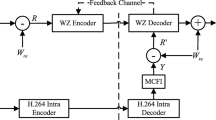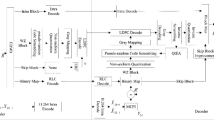Abstract
Distributed video coding (DVC) constitutes an original coding framework to meet the stringent requirements imposed by uplink-oriented and low-power mobile video applications. The quality of the side information available to the decoder and the efficiency of the employed channel codes are primary factors determining the success of a DVC system. This contribution introduces two novel techniques for probabilistic motion compensation in order to generate side information at the Wyner-Ziv decoder. The employed DVC scheme uses a base layer, serving as a hash to facilitate overlapped block motion estimation at the decoder side. On top of the base layer, a supplementary Wyner-Ziv layer is coded in the DCT domain. Both proposed probabilistic motion compensation techniques are driven by the actual correlation channel statistics and reuse information contained in the hash. Experimental results report significant rate savings caused by the novel side information generation methods compared to previous techniques. Moreover, the compression performance of the presented DVC architecture, featuring the proposed side-information generation techniques, delivers state-of-the-art compression performance.











Similar content being viewed by others
References
Aaron A, Rane S, Girod B (2004) Wyner-Ziv video coding with hash-based motion compensation at the receiver. In: IEEE International Conference on Image Processing, ICIP, Singapore, October 2004.
Aaron A, Rane S, Setton E, Girod B (2004) Transform-domain Wyner-Ziv codec for video. In: SPIE Visual Communications and Image Processing Conference, VCIP, San Jose, CA, January 2004.
Aaron A, Setton E, Girod B Towards practical Wyner-Ziv coding of video. In: IEEE International Conference on Image Processing, ICIP, Barcelona, Spain, September 2003. pp 869–872
Adikari ABB, Fernando WAC, Weerakkody WARJ, Arachchi HK (2006) Sequential motion estimation using luminance and chrominance information for distributed video coding of Wyner-Ziv frames. IEE Electron Lett 42(7):398–399
Artigas X, Ascenso J, Dalai M, Klomp S, Kubasov D, Quaret M The DISCOVER codec: Architecture, techniques and evaluation. In: Picture Coding Symposium, PCS 2007, Lisboa, Portugal, November 2007 [Online]. Available: www.discoverdvc.org. doi:www.discoverdvc.org url:
Ascenso J, Brites C, Pereira F (2006) Content adaptive Wyner-Ziv video coding driven by motion activity. In: IEEE International Conference on Image Processing, Atlanta, GA, Oct. 2006.
Ascenso J, Brites C, Pereira F (2009) A flexible side information generation framework for distributed video coding. Springer, Multimedia Tools and Applications, Special Issue on Distributed Video Coding
Ascenso J, Brites C, Pereira F Improving frame interpolation with spatial motion smoothing for pixel domain distributed video coding. In: 5th EURASIP Conference on Speech and Image Processing, Multimedia Communications and Services, Smolenice, Slovac Republic, June-July 2005.
Astély D, Dahlman E, Furuskär A, Jading Y, Lindström M, Parkvall S (2009) LTE: The Evolution of Mobile Broadband. IEEE Communications Magazine:44–51
Bjontegaard G (2001) Calculation of average PSNR differences between RD-curves. ITU-T Video Coding Experts Group (VCEG), Austin, TX
Brites C, Ascenso J, Pedro JQ, Pereira F (2008) Evaluating a feedback channel based transform domain Wyner-Ziv video codec. Signal Process Image Comm 23(4):269–297
Ciobanu L, Côrte-Real L (2010) Successive refinement of side information for multi-view distributed video coding. Springer Multimed Tools Appl 48(3):411–436
Deligiannis N, Munteanu A, Clerckx T, Cornelis J, Schelkens P (2009) Overlapped block motion estimation and probabilistic compensation with application in distributed video coding. IEEE Signal Process Lett 16(9):743–746
Deligiannis N, Munteanu A, Clerckx T, Cornelis J, Schelkens P (2009) Spatial-domain unidirectional DVC with side-information dependent correlation channel estimation. In: IEEE International Conference on Digital Signal Processing, DSP, Santorini, Greece, July 2009.
Deligiannis N, Munteanu A, Clerckx T, Cornelis J, Schelkens P On the side-information dependency of the temporal correlation in Wyner-Ziv video coding. In: IEEE International Conference on Acoustics, Speech, and Signal Processing, ICASSP 2009, Taipei, Taiwan, 19-24 April 2009. pp 709 – 712
Girod B, Aaron A, Rane S, Rebollo-Monedero D (2005) Distributed video coding. Proc IEEE 93(1):71–83
Guo X, Lu Y, Wu F, Zhao D, Gao W (2008) Wyner-Ziv-based multiview video coding. IEEE Trans Circ Syst Video Tech 18(6):713–724
Khirallah C, Stankovic V, Stankovic L, Cheng S (2009) Multiterminal source coding for multiview images under wireless fading channels. Springer Multimed Tools Appl 48(3):457–470
Kubasov D, Nayak J, Guillemot C Optimal reconstruction in Wyner-Ziv video coding with multiple side information. In: IEEE MultiMedia Signal Processing Workshop (MMSP), Chania, Crete, October 2007. pp 251–254
Martins R, Brites C, Ascenso J, Pereira F (2009) Refining side information for improved transform domain Wyner-Ziv video coding. IEEE Trans Circ Syst Video Tech 19(9):1327–1341
Mys S, Slowack J, Skorupa J, Deligiannis N, Lambert P, Munteanu A, Van de Walle R (2010) Decoder-driven mode decision in a block based distributed video codec. Springer Multimedia Tools and Applications
Orchard MT, Sullivan G (1994) Overlapped block motion compensation: An estimation-theoretic approach. IEEE Trans Image Process 3(4):693–699
Pereira F, Ascenso J, Brites C (2007) Studying the GOP size impact on the performance of a feedback channel based Wyner-Ziv video codec. In: IEEE Pacific Rim Symposium on Image Video and Technology, Santiago, Chile, December 2007.
Pradhan S, Chou J, Ramchandran K (2003) Duality between source coding and channel coding and its extension to the side information case. IEEE Trans Inform Theor 49(5):1181–1203
Puri R, Majumdar A, Ramchandran K (2007) PRISM: a video coding paradigm with motion estimation at the decoder. IEEE Trans Image Process 16(10):2436–2448
Puri R, Ramchandran K (2002) PRISM: a new robust video coding architecture based on distributed compression principles. In: 40th Allerton Conference on Communication, Control, and Computing, Allerton, IL, October 2002.
Slepian D, Wolf JK (1973) Noiseless coding of correlated information sources. IEEE Trans Inform Theor 19(4):471–480
Slowack J, Skorupa J, Deligiannis N, Lambert P, Munteanu A, Walle RVd (2011) Distributed video coding with feedback channel constraints. accepted to IEEE Transactions on Circuit and Systems for Video Technology
Varodayan D, Aaron A, Girod B (2006) Rate-adaptive codes for distributed source coding. Signal Process 86:3123–3130, Elsevier
Weinberger MJ, Seroussi G, Sapiro G (2000) The LOCO-I lossless image compression algorithm: principles and standardization into JPEG-LS. IEEE Trans Image Process 9(8):1309–1324
Wiegand T, Sullivan GJ, Bjøntegaard G, Luthra A (2003) Overview of the H.264/AVC video coding standard. IEEE Trans Circ Syst Video Tech 13(7):560–576
Wyner AD, Ziv J (1976) The rate-distortion function for source coding with side information at the decoder. IEEE Trans Inform Theor 22(1):1–10
Xiong Z, Liveris A, Cheng S (2004) Distributed source coding for sensor networks. IEEE Signal Process Mag 21:80–94
Xu Q, Stankovic V, Xiong Z (2007) Distributed joint source-channel coding of video using raptor codes. IEEE J Sel Area Comm 25(4):851–861
Zamir R (1996) The rate loss in the Wyner-Ziv problem. IEEE Trans Inform Theor 42(11):2073–2084
Zhang Y, Zhu C, Yap K (2008) A joint source-channel video coding scheme based on distributed source coding. IEEE Trans Multimed 10(8):1648–1656
Acknowledgments
This work was supported by the Fund for Scientific Research (FWO) Flanders (i.e. the postdoctoral fellowship of Peter Schelkens and the project G.0391.07. – N. Deligiannis) and by the Flemish Institute for the Promotion of Innovation by Science and Technology (IWT) – PhD bursary Frederik Verbist.
Author information
Authors and Affiliations
Corresponding author
Rights and permissions
About this article
Cite this article
Verbist, F., Deligiannis, N., Jacobs, M. et al. Probabilistic motion-compensated prediction in distributed video coding. Multimed Tools Appl 66, 405–430 (2013). https://doi.org/10.1007/s11042-012-1050-z
Published:
Issue Date:
DOI: https://doi.org/10.1007/s11042-012-1050-z




